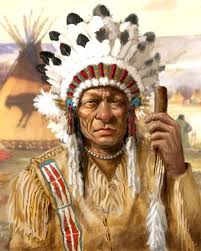|
Moderated by NW Okie! |
Volume 13 , Issue 432011Weekly eZine: (375 subscribers)Subscribe | Unsubscribe Using Desktop... |
Chief Sitting Bull (1831-1890)

Sitting Bull (Tatanka-Iyotanka) was a Hunkpapa lokota chief and holy man, whom the Lokota tribes united in their struggle for survival on the northern plains. Sitting bull remained defiant toward American military power and contemptuous of American promises to the end.
Tatanka-Iyotanka was born around 1831 on the Grand River in what is now present day South Dakota, at a place the Lakota called "many Caches" for the number of food storage pits they had dug there. The name Tatanka-Iyotanka describes a buffalo bull sitting on its haunches. Sitting Bull would live up to his name throughout his life.
Sitting Bull became a young leader of the Strong Heart warrior society and a distinguished member of the Silent Eaters, a group concerned with tribal welfare. He first went to battle at the age of 14 years in a raid on the Crow. He saw his first encounter with American soldiers in June, 1863 when the army mounted a broad campaign in retaliation for the Santee Rebellion in Minnesota.
The next year Sitting Bull fought US troops again at the Battle of Killdeer Mountain. In 1865 Sitting Bull led a siege against the newly established Fort Rice in in present-day North Dakota. Sitting Bull was respected for his bravery and insight and became head chief of the Lakota nation about 1868.
Have you heard the legend and courage of Sitting Bull in 1872, when during a battle with soldiers protecting railroad workers on the yellowstone River, Sitting Bull led four other warriors out between the lines and sat calmly sharing a pipe with them as bullets buzzed around, carefully reamed the pipe out when they were finished and then casually walked away.
Remember from your history, when in 1874 the US Army was led in an expedition by General George Armstrong Custer confirmed that gold had been discovered in the Black Hills of Dakota Territory, an area sacred to many tribes and placed off-limits to white settlement by the Fort Laramie Treaty of 1868.
Prospectors began a rush for gold in the Black Hills, which pro coked the Lakota to defend their land. Wouldn't you defend your sacred land if you were in their place? When the government efforts to purchase the Black Hills failed, the Fort Laramie Treaty was set aside and the commissioner of Indian Affairs decreed that all Lakota not on reservations by January 31, 1876, would be considered hostile. BUT . . . Sitting Bull and his people held their ground!
Could the moral to this story be, "Hold your ground when you know what is right for all!"
| View or Add Comments (0 Comments)
| Receive
updates ( subscribers) |
Unsubscribe
| © . Linda Mcgill Wagner - began © 1999 Contact Me | |
